Unilever: A Comprehensive Analysis of the FMCG Giant and its Strategy
VerifiedAdded on 2023/06/04
|9
|2168
|230
Report
AI Summary
This report provides a comprehensive analysis of Unilever, a major player in the Fast-Moving Consumer Goods (FMCG) industry. The analysis begins with a company profile and then delves into the general environmental factors affecting Unilever, including political, legal, economic, social, technological, and environmental (PESTEL) factors. It examines the company's use of technology and innovation, its marketing strategies, and its response to demographic, social, and cultural factors. The report also analyzes the industry environment, focusing on the forces of change and the attractiveness of the industry using Porter's Five Forces model. The analysis considers competitive rivalry, the threat of new entrants, customer and supplier bargaining power, and the threat of substitutes. The report concludes by highlighting Unilever's strategies and market position within the competitive landscape of the FMCG industry.
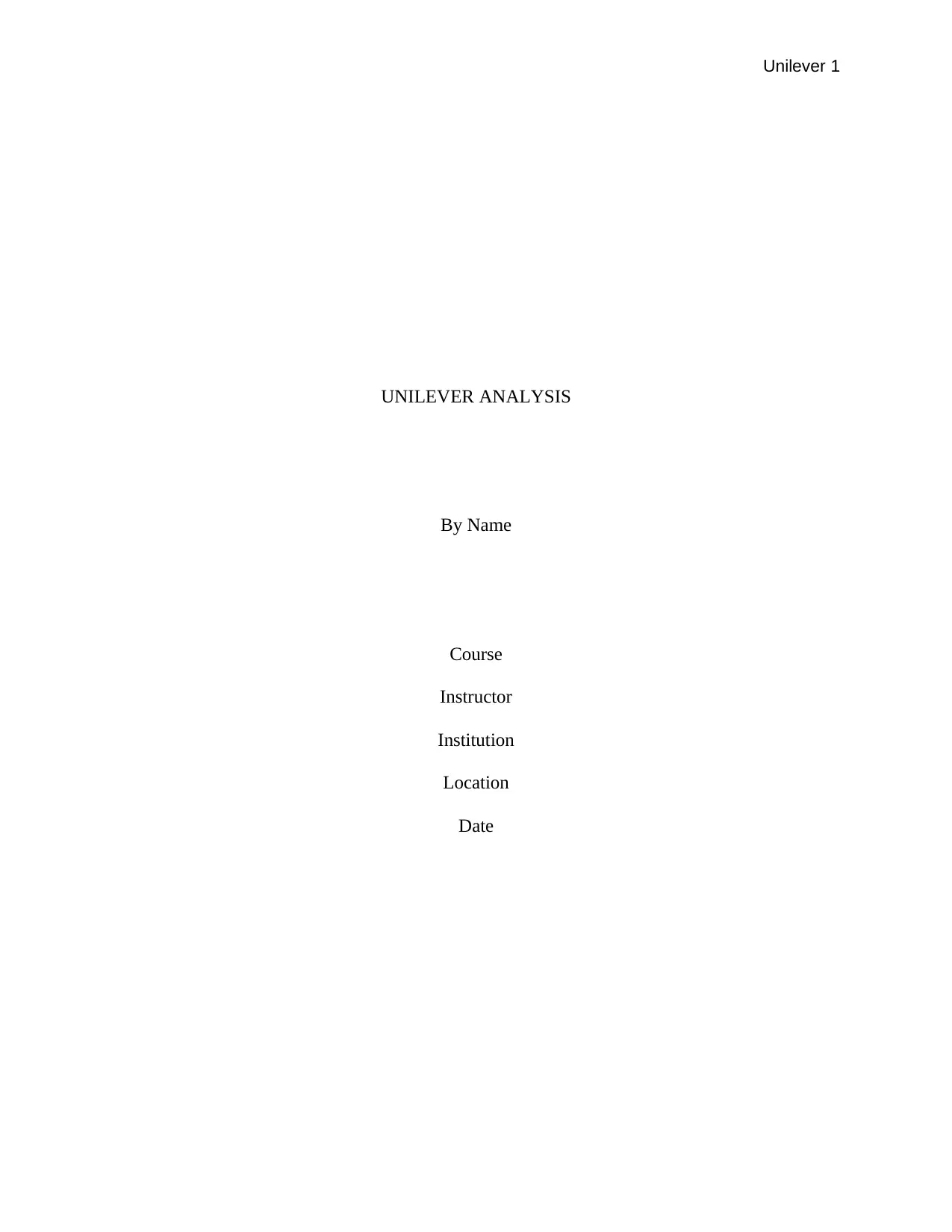
Unilever 1
UNILEVER ANALYSIS
By Name
Course
Instructor
Institution
Location
Date
UNILEVER ANALYSIS
By Name
Course
Instructor
Institution
Location
Date
Paraphrase This Document
Need a fresh take? Get an instant paraphrase of this document with our AI Paraphraser
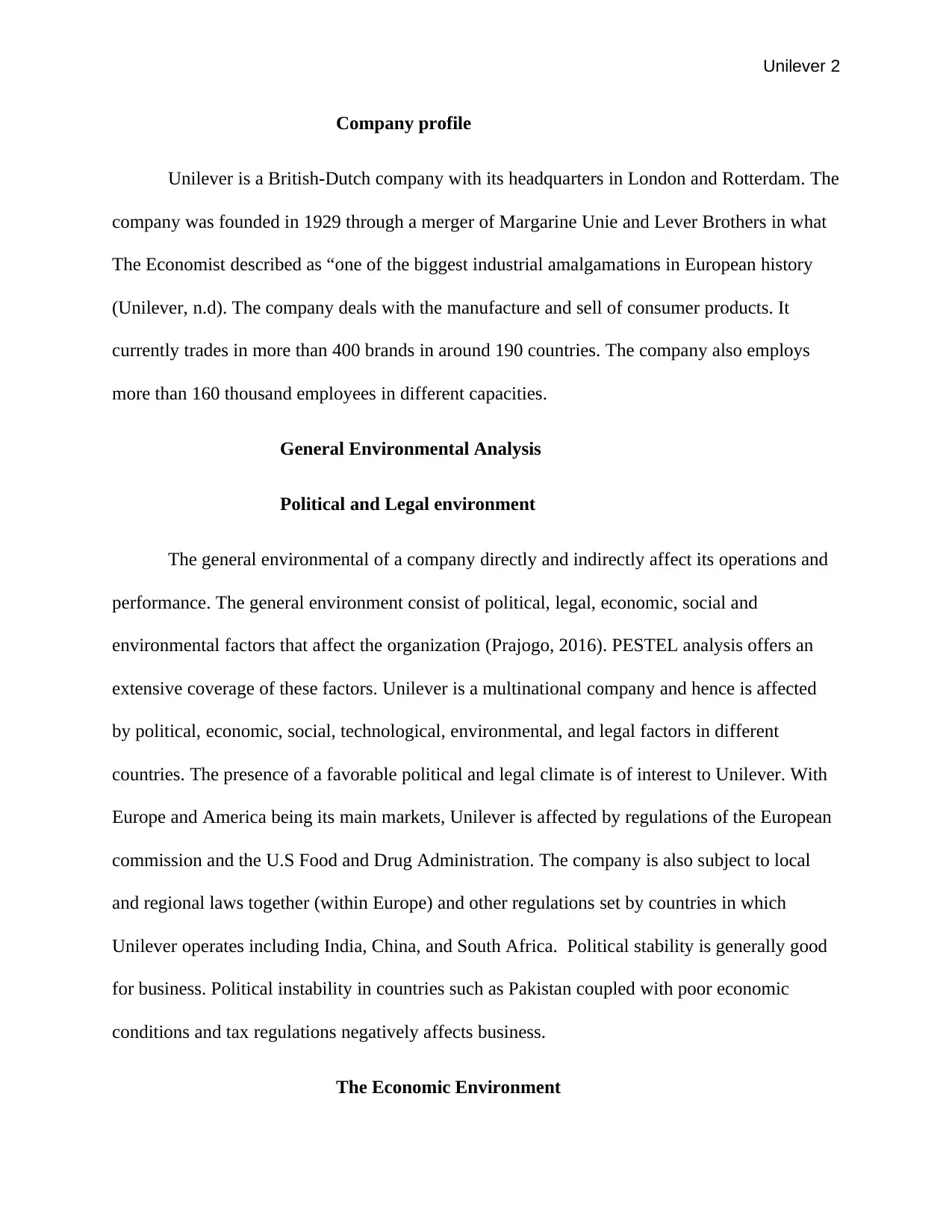
Unilever 2
Company profile
Unilever is a British-Dutch company with its headquarters in London and Rotterdam. The
company was founded in 1929 through a merger of Margarine Unie and Lever Brothers in what
The Economist described as “one of the biggest industrial amalgamations in European history
(Unilever, n.d). The company deals with the manufacture and sell of consumer products. It
currently trades in more than 400 brands in around 190 countries. The company also employs
more than 160 thousand employees in different capacities.
General Environmental Analysis
Political and Legal environment
The general environmental of a company directly and indirectly affect its operations and
performance. The general environment consist of political, legal, economic, social and
environmental factors that affect the organization (Prajogo, 2016). PESTEL analysis offers an
extensive coverage of these factors. Unilever is a multinational company and hence is affected
by political, economic, social, technological, environmental, and legal factors in different
countries. The presence of a favorable political and legal climate is of interest to Unilever. With
Europe and America being its main markets, Unilever is affected by regulations of the European
commission and the U.S Food and Drug Administration. The company is also subject to local
and regional laws together (within Europe) and other regulations set by countries in which
Unilever operates including India, China, and South Africa. Political stability is generally good
for business. Political instability in countries such as Pakistan coupled with poor economic
conditions and tax regulations negatively affects business.
The Economic Environment
Company profile
Unilever is a British-Dutch company with its headquarters in London and Rotterdam. The
company was founded in 1929 through a merger of Margarine Unie and Lever Brothers in what
The Economist described as “one of the biggest industrial amalgamations in European history
(Unilever, n.d). The company deals with the manufacture and sell of consumer products. It
currently trades in more than 400 brands in around 190 countries. The company also employs
more than 160 thousand employees in different capacities.
General Environmental Analysis
Political and Legal environment
The general environmental of a company directly and indirectly affect its operations and
performance. The general environment consist of political, legal, economic, social and
environmental factors that affect the organization (Prajogo, 2016). PESTEL analysis offers an
extensive coverage of these factors. Unilever is a multinational company and hence is affected
by political, economic, social, technological, environmental, and legal factors in different
countries. The presence of a favorable political and legal climate is of interest to Unilever. With
Europe and America being its main markets, Unilever is affected by regulations of the European
commission and the U.S Food and Drug Administration. The company is also subject to local
and regional laws together (within Europe) and other regulations set by countries in which
Unilever operates including India, China, and South Africa. Political stability is generally good
for business. Political instability in countries such as Pakistan coupled with poor economic
conditions and tax regulations negatively affects business.
The Economic Environment
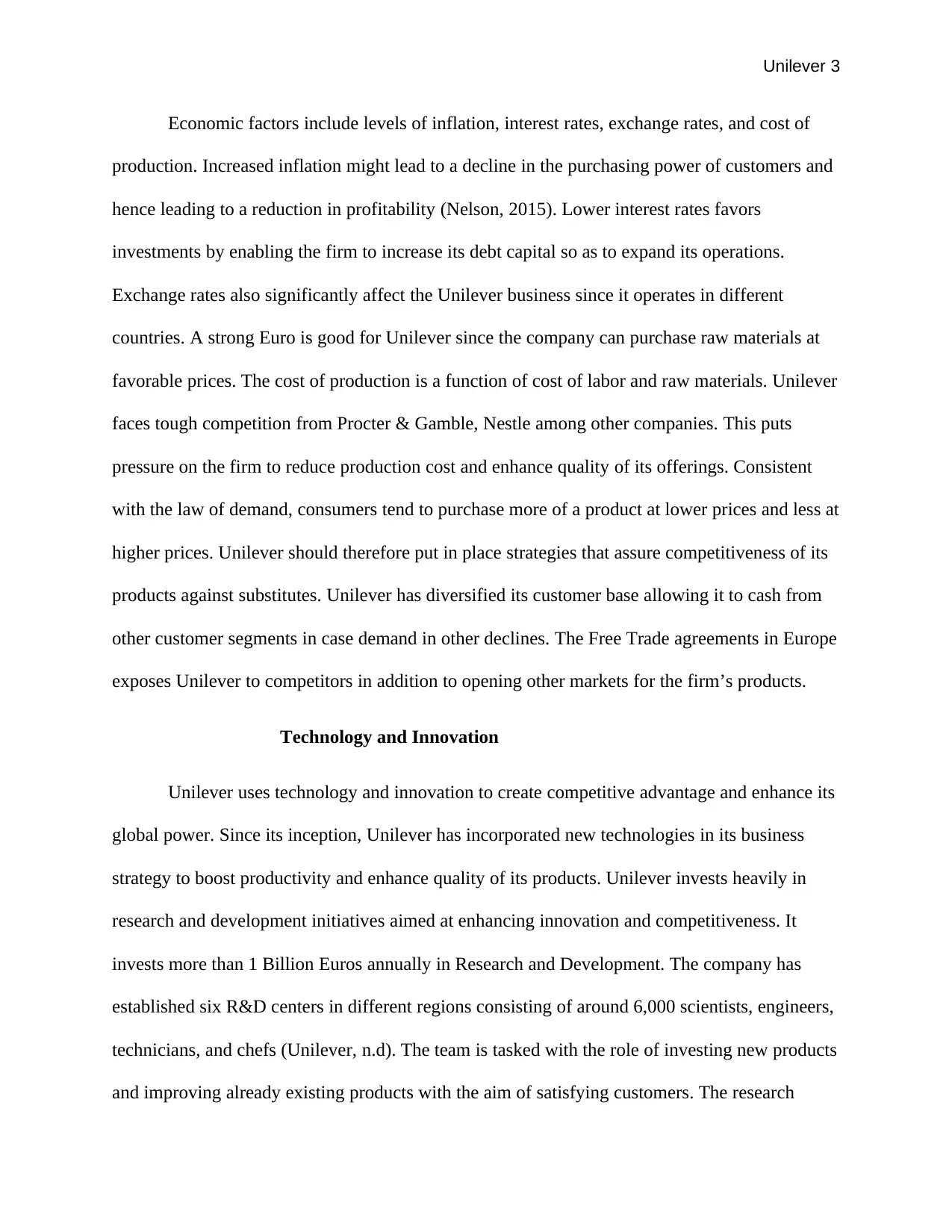
Unilever 3
Economic factors include levels of inflation, interest rates, exchange rates, and cost of
production. Increased inflation might lead to a decline in the purchasing power of customers and
hence leading to a reduction in profitability (Nelson, 2015). Lower interest rates favors
investments by enabling the firm to increase its debt capital so as to expand its operations.
Exchange rates also significantly affect the Unilever business since it operates in different
countries. A strong Euro is good for Unilever since the company can purchase raw materials at
favorable prices. The cost of production is a function of cost of labor and raw materials. Unilever
faces tough competition from Procter & Gamble, Nestle among other companies. This puts
pressure on the firm to reduce production cost and enhance quality of its offerings. Consistent
with the law of demand, consumers tend to purchase more of a product at lower prices and less at
higher prices. Unilever should therefore put in place strategies that assure competitiveness of its
products against substitutes. Unilever has diversified its customer base allowing it to cash from
other customer segments in case demand in other declines. The Free Trade agreements in Europe
exposes Unilever to competitors in addition to opening other markets for the firm’s products.
Technology and Innovation
Unilever uses technology and innovation to create competitive advantage and enhance its
global power. Since its inception, Unilever has incorporated new technologies in its business
strategy to boost productivity and enhance quality of its products. Unilever invests heavily in
research and development initiatives aimed at enhancing innovation and competitiveness. It
invests more than 1 Billion Euros annually in Research and Development. The company has
established six R&D centers in different regions consisting of around 6,000 scientists, engineers,
technicians, and chefs (Unilever, n.d). The team is tasked with the role of investing new products
and improving already existing products with the aim of satisfying customers. The research
Economic factors include levels of inflation, interest rates, exchange rates, and cost of
production. Increased inflation might lead to a decline in the purchasing power of customers and
hence leading to a reduction in profitability (Nelson, 2015). Lower interest rates favors
investments by enabling the firm to increase its debt capital so as to expand its operations.
Exchange rates also significantly affect the Unilever business since it operates in different
countries. A strong Euro is good for Unilever since the company can purchase raw materials at
favorable prices. The cost of production is a function of cost of labor and raw materials. Unilever
faces tough competition from Procter & Gamble, Nestle among other companies. This puts
pressure on the firm to reduce production cost and enhance quality of its offerings. Consistent
with the law of demand, consumers tend to purchase more of a product at lower prices and less at
higher prices. Unilever should therefore put in place strategies that assure competitiveness of its
products against substitutes. Unilever has diversified its customer base allowing it to cash from
other customer segments in case demand in other declines. The Free Trade agreements in Europe
exposes Unilever to competitors in addition to opening other markets for the firm’s products.
Technology and Innovation
Unilever uses technology and innovation to create competitive advantage and enhance its
global power. Since its inception, Unilever has incorporated new technologies in its business
strategy to boost productivity and enhance quality of its products. Unilever invests heavily in
research and development initiatives aimed at enhancing innovation and competitiveness. It
invests more than 1 Billion Euros annually in Research and Development. The company has
established six R&D centers in different regions consisting of around 6,000 scientists, engineers,
technicians, and chefs (Unilever, n.d). The team is tasked with the role of investing new products
and improving already existing products with the aim of satisfying customers. The research
⊘ This is a preview!⊘
Do you want full access?
Subscribe today to unlock all pages.

Trusted by 1+ million students worldwide
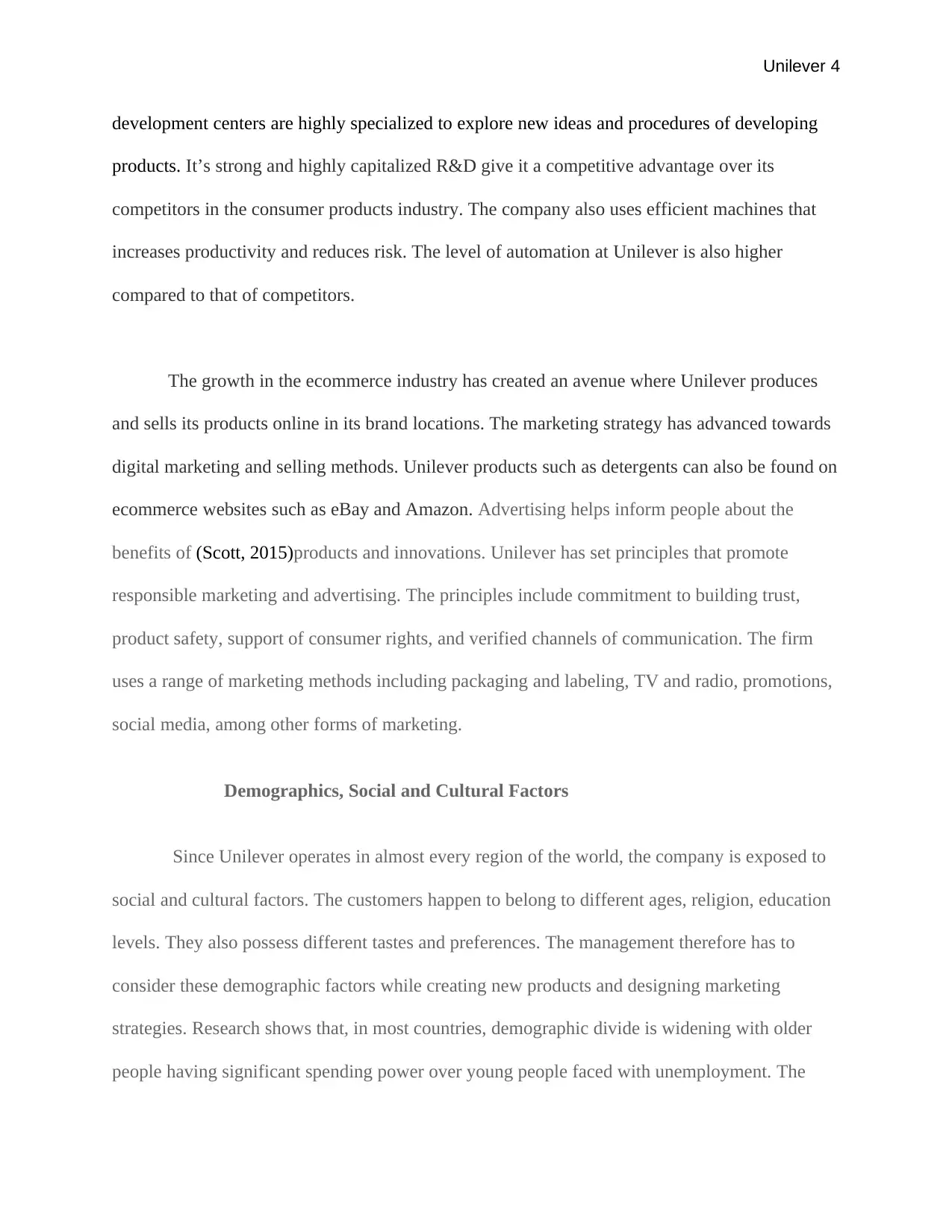
Unilever 4
development centers are highly specialized to explore new ideas and procedures of developing
products. It’s strong and highly capitalized R&D give it a competitive advantage over its
competitors in the consumer products industry. The company also uses efficient machines that
increases productivity and reduces risk. The level of automation at Unilever is also higher
compared to that of competitors.
The growth in the ecommerce industry has created an avenue where Unilever produces
and sells its products online in its brand locations. The marketing strategy has advanced towards
digital marketing and selling methods. Unilever products such as detergents can also be found on
ecommerce websites such as eBay and Amazon. Advertising helps inform people about the
benefits of (Scott, 2015)products and innovations. Unilever has set principles that promote
responsible marketing and advertising. The principles include commitment to building trust,
product safety, support of consumer rights, and verified channels of communication. The firm
uses a range of marketing methods including packaging and labeling, TV and radio, promotions,
social media, among other forms of marketing.
Demographics, Social and Cultural Factors
Since Unilever operates in almost every region of the world, the company is exposed to
social and cultural factors. The customers happen to belong to different ages, religion, education
levels. They also possess different tastes and preferences. The management therefore has to
consider these demographic factors while creating new products and designing marketing
strategies. Research shows that, in most countries, demographic divide is widening with older
people having significant spending power over young people faced with unemployment. The
development centers are highly specialized to explore new ideas and procedures of developing
products. It’s strong and highly capitalized R&D give it a competitive advantage over its
competitors in the consumer products industry. The company also uses efficient machines that
increases productivity and reduces risk. The level of automation at Unilever is also higher
compared to that of competitors.
The growth in the ecommerce industry has created an avenue where Unilever produces
and sells its products online in its brand locations. The marketing strategy has advanced towards
digital marketing and selling methods. Unilever products such as detergents can also be found on
ecommerce websites such as eBay and Amazon. Advertising helps inform people about the
benefits of (Scott, 2015)products and innovations. Unilever has set principles that promote
responsible marketing and advertising. The principles include commitment to building trust,
product safety, support of consumer rights, and verified channels of communication. The firm
uses a range of marketing methods including packaging and labeling, TV and radio, promotions,
social media, among other forms of marketing.
Demographics, Social and Cultural Factors
Since Unilever operates in almost every region of the world, the company is exposed to
social and cultural factors. The customers happen to belong to different ages, religion, education
levels. They also possess different tastes and preferences. The management therefore has to
consider these demographic factors while creating new products and designing marketing
strategies. Research shows that, in most countries, demographic divide is widening with older
people having significant spending power over young people faced with unemployment. The
Paraphrase This Document
Need a fresh take? Get an instant paraphrase of this document with our AI Paraphraser
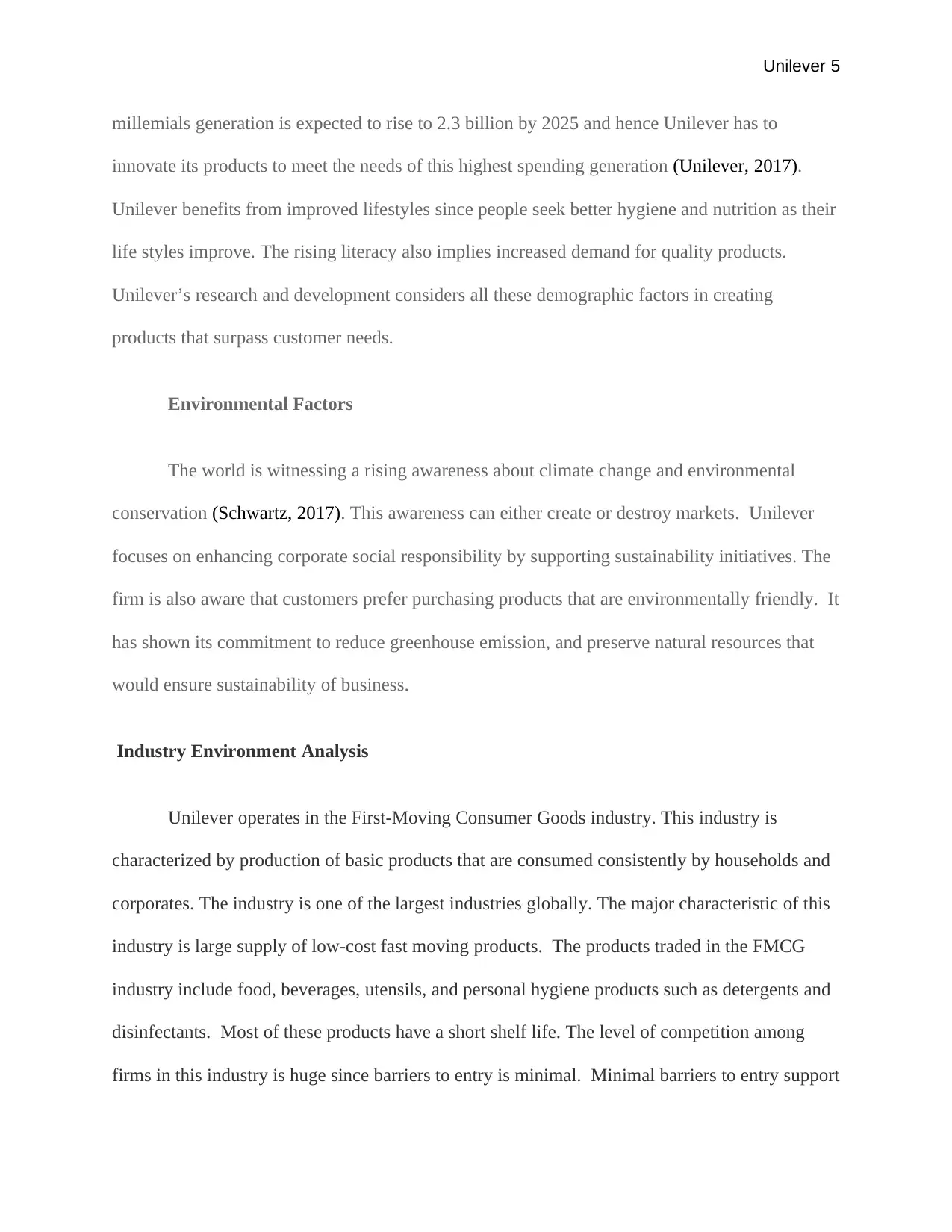
Unilever 5
millemials generation is expected to rise to 2.3 billion by 2025 and hence Unilever has to
innovate its products to meet the needs of this highest spending generation (Unilever, 2017).
Unilever benefits from improved lifestyles since people seek better hygiene and nutrition as their
life styles improve. The rising literacy also implies increased demand for quality products.
Unilever’s research and development considers all these demographic factors in creating
products that surpass customer needs.
Environmental Factors
The world is witnessing a rising awareness about climate change and environmental
conservation (Schwartz, 2017). This awareness can either create or destroy markets. Unilever
focuses on enhancing corporate social responsibility by supporting sustainability initiatives. The
firm is also aware that customers prefer purchasing products that are environmentally friendly. It
has shown its commitment to reduce greenhouse emission, and preserve natural resources that
would ensure sustainability of business.
Industry Environment Analysis
Unilever operates in the First-Moving Consumer Goods industry. This industry is
characterized by production of basic products that are consumed consistently by households and
corporates. The industry is one of the largest industries globally. The major characteristic of this
industry is large supply of low-cost fast moving products. The products traded in the FMCG
industry include food, beverages, utensils, and personal hygiene products such as detergents and
disinfectants. Most of these products have a short shelf life. The level of competition among
firms in this industry is huge since barriers to entry is minimal. Minimal barriers to entry support
millemials generation is expected to rise to 2.3 billion by 2025 and hence Unilever has to
innovate its products to meet the needs of this highest spending generation (Unilever, 2017).
Unilever benefits from improved lifestyles since people seek better hygiene and nutrition as their
life styles improve. The rising literacy also implies increased demand for quality products.
Unilever’s research and development considers all these demographic factors in creating
products that surpass customer needs.
Environmental Factors
The world is witnessing a rising awareness about climate change and environmental
conservation (Schwartz, 2017). This awareness can either create or destroy markets. Unilever
focuses on enhancing corporate social responsibility by supporting sustainability initiatives. The
firm is also aware that customers prefer purchasing products that are environmentally friendly. It
has shown its commitment to reduce greenhouse emission, and preserve natural resources that
would ensure sustainability of business.
Industry Environment Analysis
Unilever operates in the First-Moving Consumer Goods industry. This industry is
characterized by production of basic products that are consumed consistently by households and
corporates. The industry is one of the largest industries globally. The major characteristic of this
industry is large supply of low-cost fast moving products. The products traded in the FMCG
industry include food, beverages, utensils, and personal hygiene products such as detergents and
disinfectants. Most of these products have a short shelf life. The level of competition among
firms in this industry is huge since barriers to entry is minimal. Minimal barriers to entry support
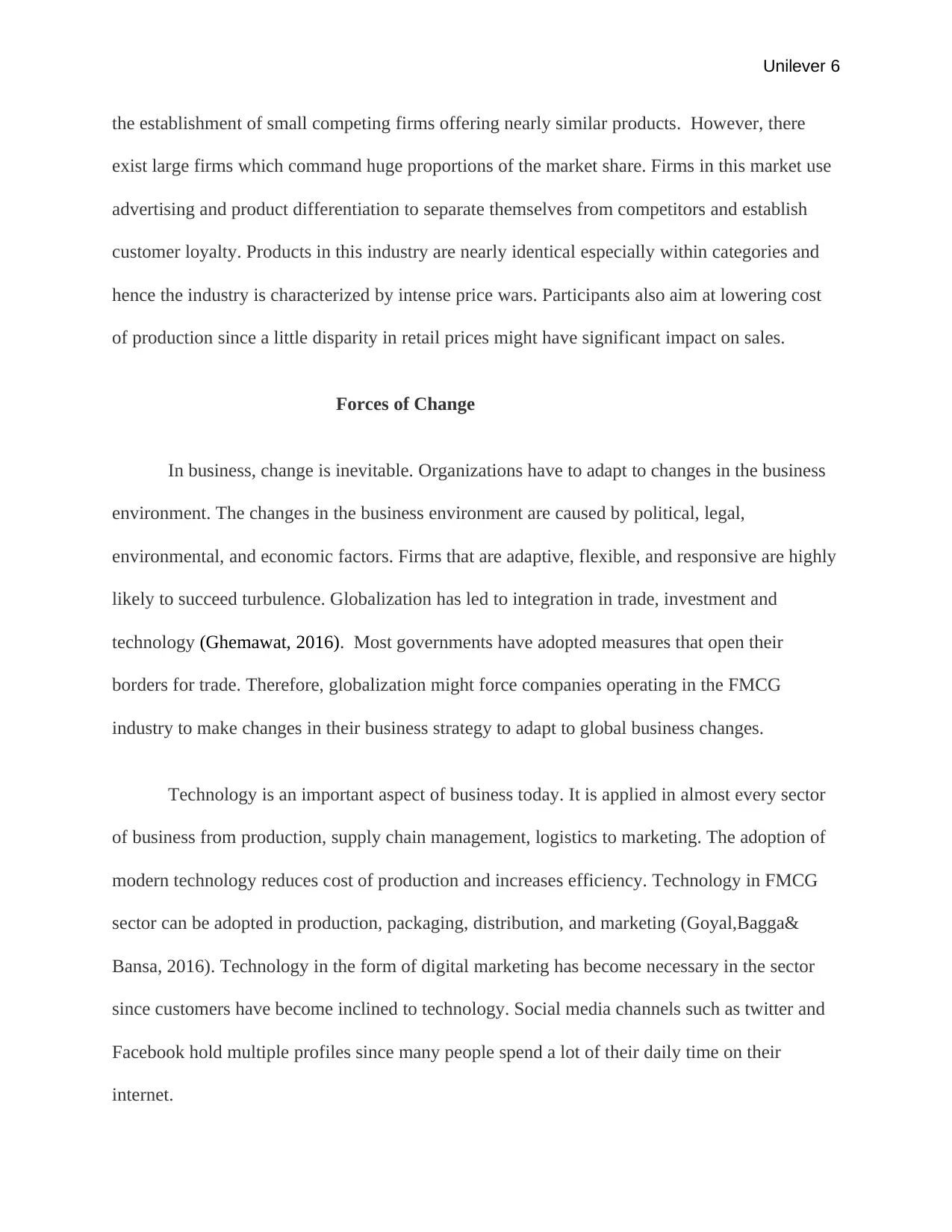
Unilever 6
the establishment of small competing firms offering nearly similar products. However, there
exist large firms which command huge proportions of the market share. Firms in this market use
advertising and product differentiation to separate themselves from competitors and establish
customer loyalty. Products in this industry are nearly identical especially within categories and
hence the industry is characterized by intense price wars. Participants also aim at lowering cost
of production since a little disparity in retail prices might have significant impact on sales.
Forces of Change
In business, change is inevitable. Organizations have to adapt to changes in the business
environment. The changes in the business environment are caused by political, legal,
environmental, and economic factors. Firms that are adaptive, flexible, and responsive are highly
likely to succeed turbulence. Globalization has led to integration in trade, investment and
technology (Ghemawat, 2016). Most governments have adopted measures that open their
borders for trade. Therefore, globalization might force companies operating in the FMCG
industry to make changes in their business strategy to adapt to global business changes.
Technology is an important aspect of business today. It is applied in almost every sector
of business from production, supply chain management, logistics to marketing. The adoption of
modern technology reduces cost of production and increases efficiency. Technology in FMCG
sector can be adopted in production, packaging, distribution, and marketing (Goyal,Bagga&
Bansa, 2016). Technology in the form of digital marketing has become necessary in the sector
since customers have become inclined to technology. Social media channels such as twitter and
Facebook hold multiple profiles since many people spend a lot of their daily time on their
internet.
the establishment of small competing firms offering nearly similar products. However, there
exist large firms which command huge proportions of the market share. Firms in this market use
advertising and product differentiation to separate themselves from competitors and establish
customer loyalty. Products in this industry are nearly identical especially within categories and
hence the industry is characterized by intense price wars. Participants also aim at lowering cost
of production since a little disparity in retail prices might have significant impact on sales.
Forces of Change
In business, change is inevitable. Organizations have to adapt to changes in the business
environment. The changes in the business environment are caused by political, legal,
environmental, and economic factors. Firms that are adaptive, flexible, and responsive are highly
likely to succeed turbulence. Globalization has led to integration in trade, investment and
technology (Ghemawat, 2016). Most governments have adopted measures that open their
borders for trade. Therefore, globalization might force companies operating in the FMCG
industry to make changes in their business strategy to adapt to global business changes.
Technology is an important aspect of business today. It is applied in almost every sector
of business from production, supply chain management, logistics to marketing. The adoption of
modern technology reduces cost of production and increases efficiency. Technology in FMCG
sector can be adopted in production, packaging, distribution, and marketing (Goyal,Bagga&
Bansa, 2016). Technology in the form of digital marketing has become necessary in the sector
since customers have become inclined to technology. Social media channels such as twitter and
Facebook hold multiple profiles since many people spend a lot of their daily time on their
internet.
⊘ This is a preview!⊘
Do you want full access?
Subscribe today to unlock all pages.

Trusted by 1+ million students worldwide
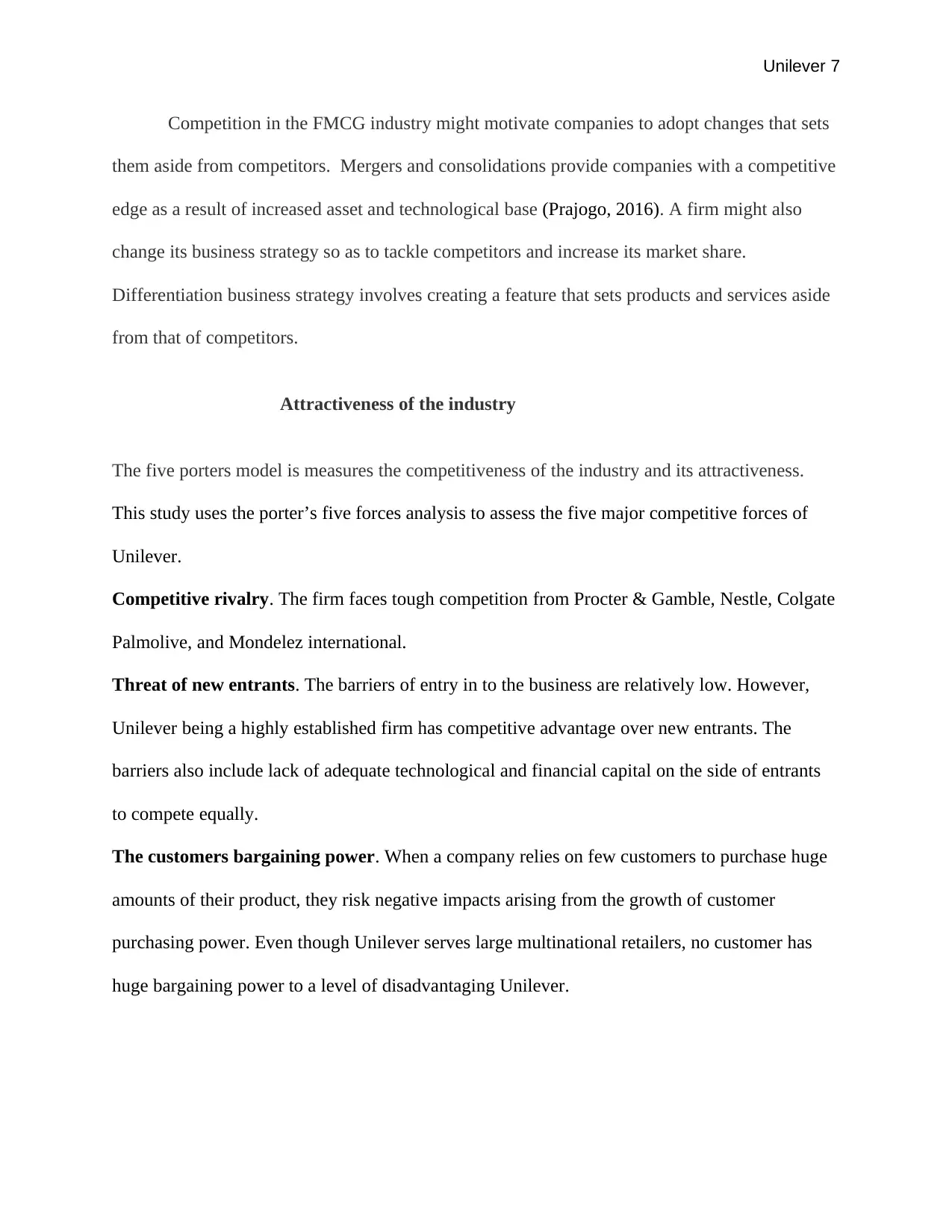
Unilever 7
Competition in the FMCG industry might motivate companies to adopt changes that sets
them aside from competitors. Mergers and consolidations provide companies with a competitive
edge as a result of increased asset and technological base (Prajogo, 2016). A firm might also
change its business strategy so as to tackle competitors and increase its market share.
Differentiation business strategy involves creating a feature that sets products and services aside
from that of competitors.
Attractiveness of the industry
The five porters model is measures the competitiveness of the industry and its attractiveness.
This study uses the porter’s five forces analysis to assess the five major competitive forces of
Unilever.
Competitive rivalry. The firm faces tough competition from Procter & Gamble, Nestle, Colgate
Palmolive, and Mondelez international.
Threat of new entrants. The barriers of entry in to the business are relatively low. However,
Unilever being a highly established firm has competitive advantage over new entrants. The
barriers also include lack of adequate technological and financial capital on the side of entrants
to compete equally.
The customers bargaining power. When a company relies on few customers to purchase huge
amounts of their product, they risk negative impacts arising from the growth of customer
purchasing power. Even though Unilever serves large multinational retailers, no customer has
huge bargaining power to a level of disadvantaging Unilever.
Competition in the FMCG industry might motivate companies to adopt changes that sets
them aside from competitors. Mergers and consolidations provide companies with a competitive
edge as a result of increased asset and technological base (Prajogo, 2016). A firm might also
change its business strategy so as to tackle competitors and increase its market share.
Differentiation business strategy involves creating a feature that sets products and services aside
from that of competitors.
Attractiveness of the industry
The five porters model is measures the competitiveness of the industry and its attractiveness.
This study uses the porter’s five forces analysis to assess the five major competitive forces of
Unilever.
Competitive rivalry. The firm faces tough competition from Procter & Gamble, Nestle, Colgate
Palmolive, and Mondelez international.
Threat of new entrants. The barriers of entry in to the business are relatively low. However,
Unilever being a highly established firm has competitive advantage over new entrants. The
barriers also include lack of adequate technological and financial capital on the side of entrants
to compete equally.
The customers bargaining power. When a company relies on few customers to purchase huge
amounts of their product, they risk negative impacts arising from the growth of customer
purchasing power. Even though Unilever serves large multinational retailers, no customer has
huge bargaining power to a level of disadvantaging Unilever.
Paraphrase This Document
Need a fresh take? Get an instant paraphrase of this document with our AI Paraphraser
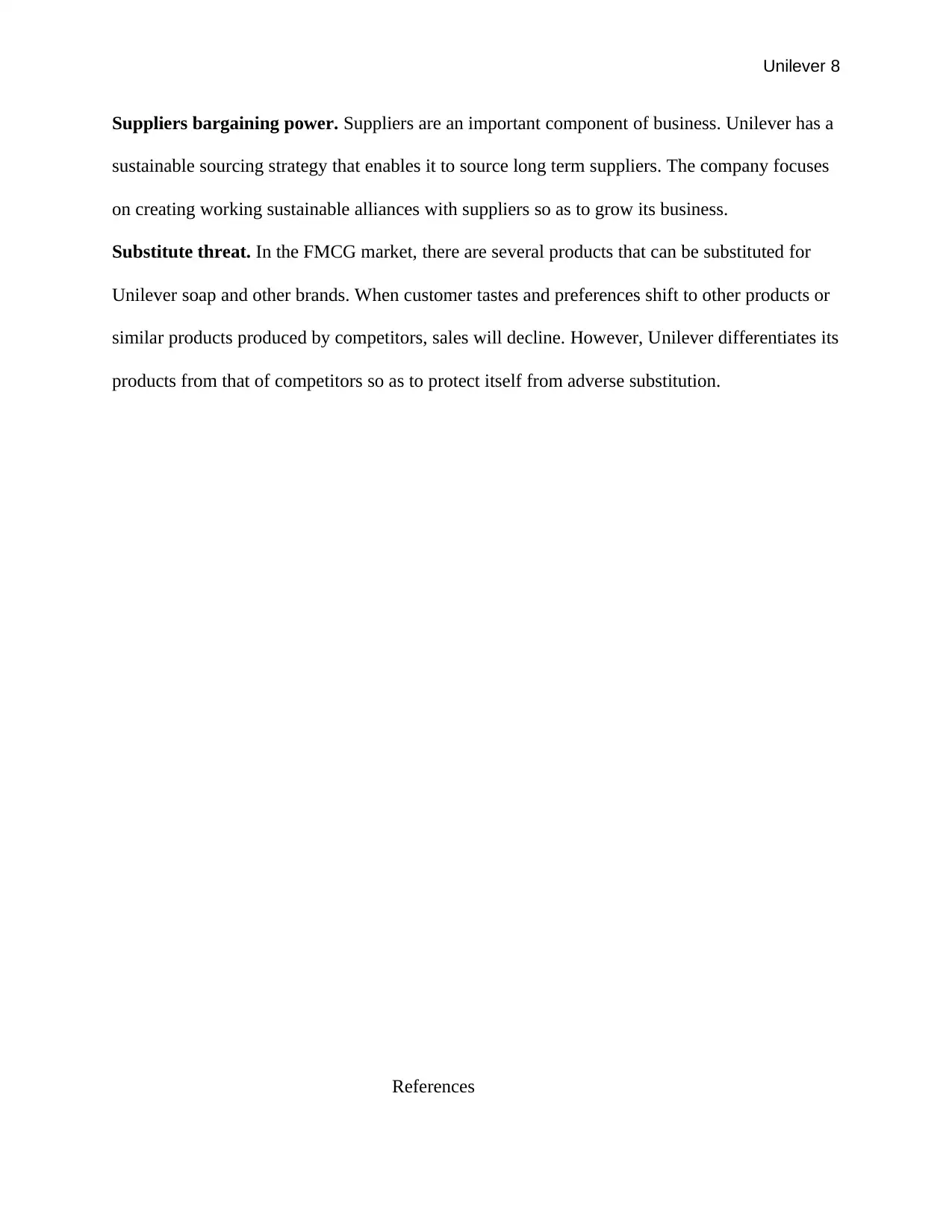
Unilever 8
Suppliers bargaining power. Suppliers are an important component of business. Unilever has a
sustainable sourcing strategy that enables it to source long term suppliers. The company focuses
on creating working sustainable alliances with suppliers so as to grow its business.
Substitute threat. In the FMCG market, there are several products that can be substituted for
Unilever soap and other brands. When customer tastes and preferences shift to other products or
similar products produced by competitors, sales will decline. However, Unilever differentiates its
products from that of competitors so as to protect itself from adverse substitution.
References
Suppliers bargaining power. Suppliers are an important component of business. Unilever has a
sustainable sourcing strategy that enables it to source long term suppliers. The company focuses
on creating working sustainable alliances with suppliers so as to grow its business.
Substitute threat. In the FMCG market, there are several products that can be substituted for
Unilever soap and other brands. When customer tastes and preferences shift to other products or
similar products produced by competitors, sales will decline. However, Unilever differentiates its
products from that of competitors so as to protect itself from adverse substitution.
References
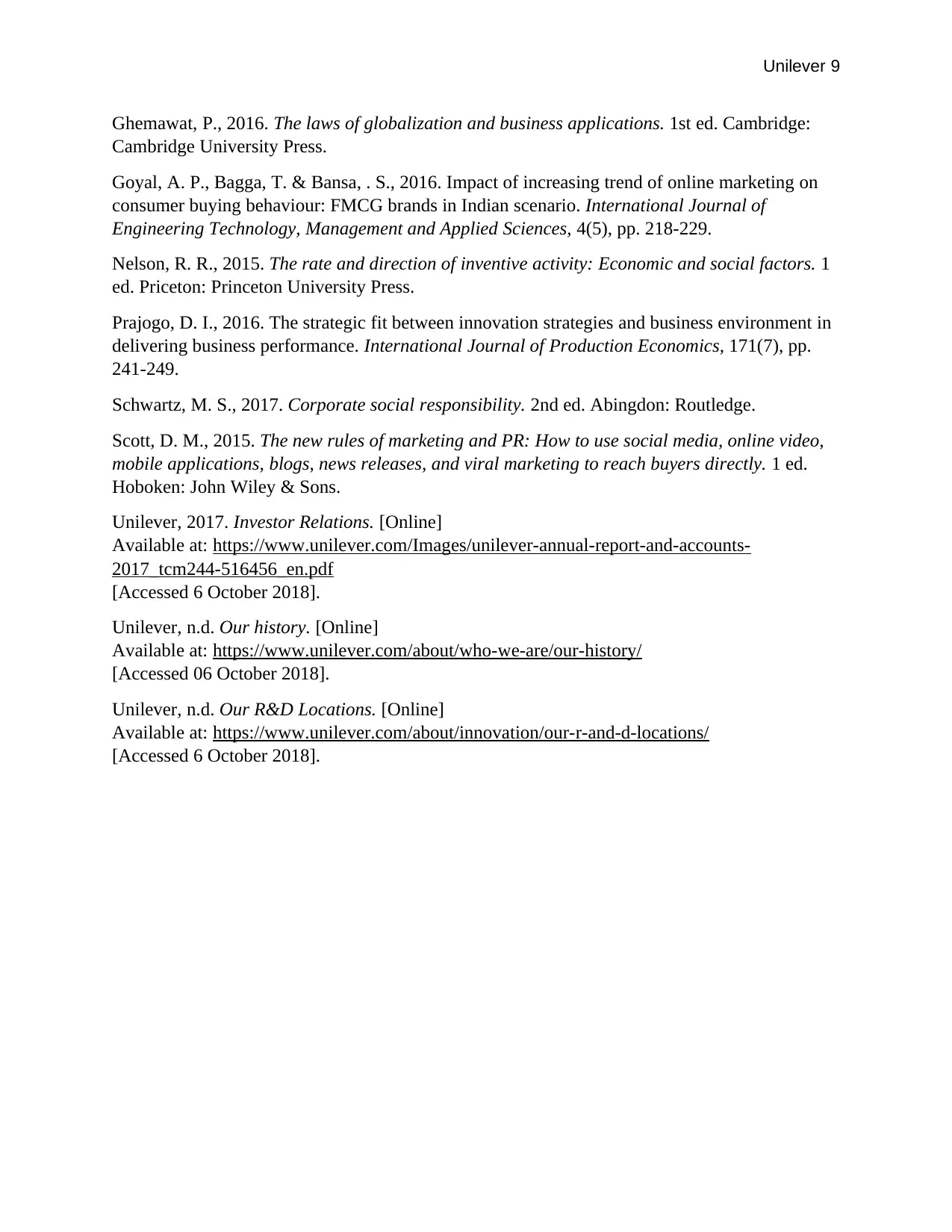
Unilever 9
Ghemawat, P., 2016. The laws of globalization and business applications. 1st ed. Cambridge:
Cambridge University Press.
Goyal, A. P., Bagga, T. & Bansa, . S., 2016. Impact of increasing trend of online marketing on
consumer buying behaviour: FMCG brands in Indian scenario. International Journal of
Engineering Technology, Management and Applied Sciences, 4(5), pp. 218-229.
Nelson, R. R., 2015. The rate and direction of inventive activity: Economic and social factors. 1
ed. Priceton: Princeton University Press.
Prajogo, D. I., 2016. The strategic fit between innovation strategies and business environment in
delivering business performance. International Journal of Production Economics, 171(7), pp.
241-249.
Schwartz, M. S., 2017. Corporate social responsibility. 2nd ed. Abingdon: Routledge.
Scott, D. M., 2015. The new rules of marketing and PR: How to use social media, online video,
mobile applications, blogs, news releases, and viral marketing to reach buyers directly. 1 ed.
Hoboken: John Wiley & Sons.
Unilever, 2017. Investor Relations. [Online]
Available at: https://www.unilever.com/Images/unilever-annual-report-and-accounts-
2017_tcm244-516456_en.pdf
[Accessed 6 October 2018].
Unilever, n.d. Our history. [Online]
Available at: https://www.unilever.com/about/who-we-are/our-history/
[Accessed 06 October 2018].
Unilever, n.d. Our R&D Locations. [Online]
Available at: https://www.unilever.com/about/innovation/our-r-and-d-locations/
[Accessed 6 October 2018].
Ghemawat, P., 2016. The laws of globalization and business applications. 1st ed. Cambridge:
Cambridge University Press.
Goyal, A. P., Bagga, T. & Bansa, . S., 2016. Impact of increasing trend of online marketing on
consumer buying behaviour: FMCG brands in Indian scenario. International Journal of
Engineering Technology, Management and Applied Sciences, 4(5), pp. 218-229.
Nelson, R. R., 2015. The rate and direction of inventive activity: Economic and social factors. 1
ed. Priceton: Princeton University Press.
Prajogo, D. I., 2016. The strategic fit between innovation strategies and business environment in
delivering business performance. International Journal of Production Economics, 171(7), pp.
241-249.
Schwartz, M. S., 2017. Corporate social responsibility. 2nd ed. Abingdon: Routledge.
Scott, D. M., 2015. The new rules of marketing and PR: How to use social media, online video,
mobile applications, blogs, news releases, and viral marketing to reach buyers directly. 1 ed.
Hoboken: John Wiley & Sons.
Unilever, 2017. Investor Relations. [Online]
Available at: https://www.unilever.com/Images/unilever-annual-report-and-accounts-
2017_tcm244-516456_en.pdf
[Accessed 6 October 2018].
Unilever, n.d. Our history. [Online]
Available at: https://www.unilever.com/about/who-we-are/our-history/
[Accessed 06 October 2018].
Unilever, n.d. Our R&D Locations. [Online]
Available at: https://www.unilever.com/about/innovation/our-r-and-d-locations/
[Accessed 6 October 2018].
⊘ This is a preview!⊘
Do you want full access?
Subscribe today to unlock all pages.

Trusted by 1+ million students worldwide
1 out of 9
Related Documents
Your All-in-One AI-Powered Toolkit for Academic Success.
+13062052269
info@desklib.com
Available 24*7 on WhatsApp / Email
![[object Object]](/_next/static/media/star-bottom.7253800d.svg)
Unlock your academic potential
Copyright © 2020–2025 A2Z Services. All Rights Reserved. Developed and managed by ZUCOL.




